Food
The trials and tribulations of home-baking
The process often turns into a series of unfortunate events, leading to crumbled dreams and deflated ambitions. But why do these mishaps happen? And most importantly, how do we overcome them?
Samundra Gurung
I can vividly remember my first encounter with baking when I was 10 years old. We had just moved to our new home and got a cable connection. The cable opened a world of possibilities, as it gave me access to various contents.
This was back in the late 2000s when YouTube would take hours to load, taunting us with its buffering screen. I was particularly drawn to travel and lifestyle channels, mainly TLC, Fox Life, and Food Network, which kept me informed about different foods and cultures.
I don’t know why, but I was always drawn to desserts. It was fascinating to see how these miraculous treats made people smile at the end of the meal.
Growing up in Nepal, I noticed that baking wasn't very common. While some families did have ovens, they were mostly multifunctional ones used primarily for heating food.
I also noticed that most of our desserts didn't require an oven, as they could be made on a stovetop. So, you can imagine my excitement when my mom decided to buy an oven during one of her festive shopping sprees.
I could finally feel the joy these channels portrayed. (I blame food writer Nigella Lawson for getting me hooked on a domestic lifestyle.)
Then, one day, after watching one of the cooking episodes on television, I finally mustered enough strength and decided to bake something. I distinctly remember wanting to make a chocolate cake for myself after watching one of Rachel Allen’s bake series.
I watched all the ingredients used in that recipe and scurried across my pantry, only to realise I didn’t have half of the stuff she mentioned. I then decided to improvise the recipe (a big mistake). I randomly combined the ingredients that I had in a mixing bowl and chucked the batter into my oven, hoping for a magical cake to pop out an hour later.
After I saw the result an hour later, I was mortified. The cake was stuck in the pan, refusing to come out, and it was as dense as fudge. I convinced myself that the taste was what mattered most, but when I served a slice to my brother, he made a face of utter disgust.
That was the day I realised that baking soda was not the same as baking powder.
After this incident, I researched baking and found out it was technical. This was a blessing in disguise for me, as I loved science, and I started to view baking as a science experiment. I then reflected and evaluated how to perfect one's baking skills.
I analysed my errors and noted down all the steps I did every time I baked. Home baking is a passion for many. The idea of turning a few simple ingredients into a delicious masterpiece is as enchanting as it sounds.
Yet, for many of us, this seemingly magical process can often turn into a series of unfortunate events, leading to crumbled dreams and deflated ambitions. Dense cakes, burnt crusts, rock-hard cookies and unrisen bread, if you are an amateur baker, then you have seen it all.
But why do these mishaps happen so often? And most importantly how do we overcome them?
From my experience, behind every successful bake lies a series of challenges and mishaps that test even the most dedicated bakers. Baking has its own set of rules that you need to follow to get that scrumptious treat every time.
So, to transform a recipe into an actual dish that will impress your friends and family, I am sharing with you some of the tips and tricks I learned from my tumultuous journey as a home baker.
First things first, we have to look into the prime appliance that we are working with. Commercial ovens are of two types: one that runs on gas and the other that runs on electricity. We have to look at the oven present at our home and consider its pros and cons.
The main benefits of a gas oven are its size and temperature control. One can quickly change the temperature just by twisting the knob, and it preheats much more quickly than an electric one. However, they are known to have uneven temperatures at times and release more humidity, making it harder to properly crisp or brown food.

This can result in burnt edges and cold or hot spots. An electric oven, on the other hand, provides more even and consistent temperatures and doesn’t release as much moisture in the air.
This dry oven environment makes it easier to brown your items, making it great for baking bread. However, while the dry oven results in more even cooking, you also run the risk of drying out cakes and other baked goods.
Also, many people forget to preheat the oven before baking, which is crucial for maintaining an even temperature throughout the baking process. When baking cakes and bread, I like to place a small tray of water at the bottom of the oven to provide moisture and prevent the baked goods from drying out.
An oven thermometer can be a baker's best friend, providing a true reading and ensuring your creations bake evenly. I also like rotating the pan midway while baking, as it allows for an even distribution of heat.
The next thing people mess up on is measuring and the specificity of ingredients in a recipe. Our moms made our food with their instinct; it is something that they learned along the way, but when you are baking, you cannot instinctively add or omit a few steps.
I think that is why we initially had problems with baking. In a culture where cooking comes instinctually, baking challenges us, to be precise. A gram of more or less of any ingredient can drastically alter the outcome. Different methods of measuring flour can yield different results.
Every component in baking serves a distinct purpose and function. Flour offers structure, sugar adds sweetness and moisture, eggs bind things together, and butter enhances taste and texture. However, not all ingredients are created equally. For example, using salted butter instead of unsalted might change the taste profile of your meal.
Similarly, different flours have varying protein concentrations, which affect the texture of baked goods. The type of sugar used also makes a difference. Granulated sugar, brown sugar, powdered sugar, and speciality sugars like turbinado or muscovado each add unique flavours to a bake.
Understanding these nuances and how they interact is critical for getting the intended outcomes. Accurate measurement tools and techniques are essential, but mastering them can be a steep learning curve. So, I would recommend investing in a kitchen scale that allows for more accurate measurements by weight rather than volume.
Moving on, leavening agents such as baking soda, baking powder, and yeast are required to make baked goods rise. However, they can also cause confusion and errors. Baking soda needs an acidic component to activate, but baking powder has both an acid and a base, making it self-activating.
Using the wrong type of flour or sugar, or using them in incorrect proportions, can result in flat, overly raised, or collapsed cakes. Yeast, being a living organism, presents its challenges.
The water temperature must be just right—not too hot to kill the yeast, nor too cold to inhibit its activity. Proofing times and conditions also need to be carefully managed to achieve the perfect rise.
Bakers should also be careful about the way they mix ingredients. The method of mixing ingredients can significantly impact the final product. Over-mixing can develop too much gluten in cakes and pastries, leading to tough textures.
Under-mixing can leave pockets of unincorporated ingredients, resulting in uneven bakes. Techniques like folding, creaming, and whipping each serve specific purposes and must be executed with care.
Finally, home bakers must understand the importance of timing and patience in baking. Even a minute or two can make the difference between perfectly baked cookies and burnt edges.
Recipes often provide a range for baking times, but factors like oven hot spots, pan material, and altitude can affect these times. It’s crucial to keep a close eye on your bakes and rely on visual and tactile cues, such as a cake pulling away from the sides of the pan or a toothpick coming out clean, to determine doneness.
Baking is also an exercise in patience, a virtue not everyone possesses. Doughs need time to rest and rise, flavours need time to meld, and baked goods need time to cool before they can be enjoyed.
Impatience can lead to underbaked centres, crumbling slices, and a general sense of frustration. Cultivating patience is as important as mastering any technique in the baker’s repertoire.
Home baking is a journey full of ups and downs, but it comes with great rewards. The obstacles encountered teach valuable lessons in patience, precision, and perseverance.
The satisfaction of success, the freedom to create, and the therapeutic benefits make the endeavour meaningful. Whether baking for oneself, loved ones, or as an artistic outlet, the journey is as fulfilling as the result. Embrace the flour-dusted countertops, occasional setbacks, and the joys of home baking
For a beginner-friendly recipe that involves mixing ingredients and delivers amazing results, try my recipe for fudgy, nutty brownies that I call ‘Bliss Brownies’.
Bliss Brownies
150g unsalted butter plus extra for the tin
150g chopped dark chocolate
200g caster sugar
½ tsp baking powder
2 eggs
80g cocoa powder
150g plain flour
70g mixture of nuts (walnuts and almonds)
60g blended papaya
Mix all the ingredients (except the dark chocolate and nuts) in a blender or a food processor and blitz till you get a smooth paste.
Fold the chocolate and the nuts into the brownie batter, making sure that the pieces are evenly mixed in.
Grease a loaf pan with soft butter and dust with cocoa powder. Pour the batter into the loaf pan.
Bake in a preheated oven at 170c for 40 minutes and let it cool in the oven for an hour. Enjoy with a cup of coffee or, as I like it, a scoop of vanilla ice cream.




 5.39°C Kathmandu
5.39°C Kathmandu









%20(1).jpg&w=300&height=200)

